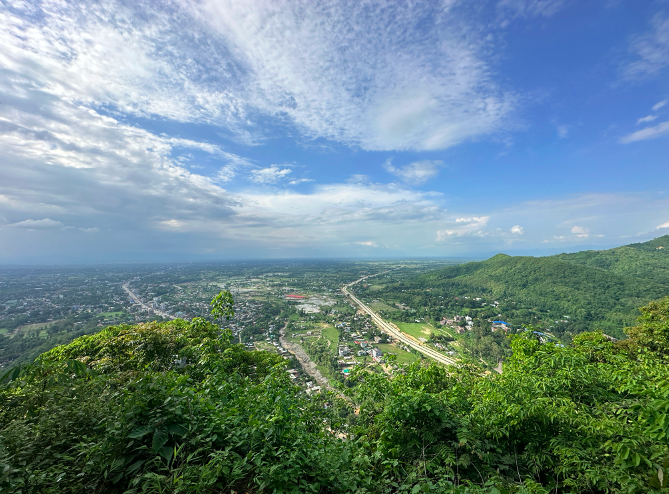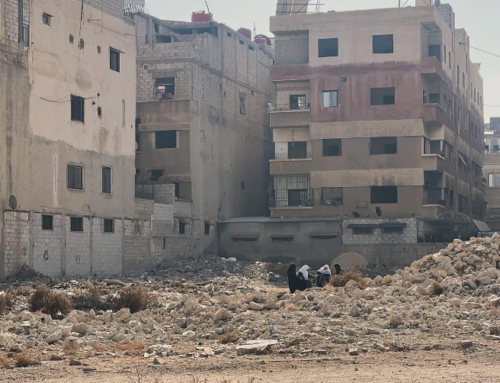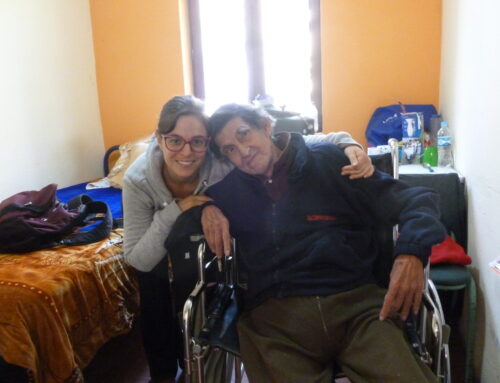Early last year, I was texting with an old friend, Alika, who lives in Chümoukedima, Nagaland, located in the northeastern region of India. We were talking about my summer fieldwork plans. When I told her I would be renting an empty house for about two months at a location close to her home, she offered to lend me a few household items, including her extra LPG cooking gas cylinder and stove. “Don’t worry, I have secured an [electric] induction cooker…” I texted her. “Then prepare to go without food some days,” she replied. We both laughed, but I think she laughed harder. As it turned out, this text exchange would dawn hard on me during my summer fieldwork.

A view of the rapidly urbanizing Chümoukedima town. It was the first district headquarters to the then Naga Hills District of Colonial Assam. Photo by author.
On a Sunday morning in July, I woke up perspiring. I looked up at the ceiling with my fatigued half-opened eyes. The fan blades were still. The electricity had been off for a while. Although I had lived in Dimapur for a few years during my school days, my body could not adjust to the heat without a fan, at a minimum. Dimapur had become much hotter over the years, and I had gotten used to living in cooler weather conditions.
Here in the Naga lowlands, the hot season lasts for more than six months. Starting late March until mid-October, the temperature is above 32 degrees Celsius (roughly 90 Fahrenheit). This, of course, cannot compare to Delhi, or Kolkata, where it is not uncommon for temperature to rise above 40 degrees Celsius (104 Fahrenheit) during the peak summer months. Nonetheless, like these cities, the months from May to July are the hottest in Nagaland. While I barely managed to stay calm and cool myself in the heat, I quickly became more worried about my food when the electricity did not come back on until 2 PM. I had no option but to take my scooter out in the hot sun, scouting to find cooked food.
The power cut I experienced that day, known as “load shedding,” is a predominant phenomenon in India’s Northeastern borderlands. In simple terms, load shedding refers to the interruption of power supply to ensure voltage stability. This is done when the demand for electricity is higher than the supply of electricity. During all three of my preliminary fieldwork stays in Nagaland, and especially during my two summer stays, hardly a day went by without interruptions to the electricity. This common occurrence meant that power cuts were woven into the fabric of everyday life; as a result, I ended up having frequent conversations with friends and relatives in Nagaland about load shedding, with reference to heat. In the Naga lowlands, load shedding is thought of as heat—that is, Naga people conceive of, respond to, and give meaning to heat through the concept of load shedding. I am not the first to observe this. In their book, Ceasefire City, Dolly Kikon and Duncan McDuie-Ra (2021) wrote about the erratic power supply in Dimapur, because of which the Power Department frequently receives “frantic calls.”
Electric history of India
At the time of India’s independence, the power sector was largely privately-owned and fragmented. Furthermore, more than 70% of the electricity was directed towards industrial use, with household consumption of electricity being limited to a few urban centers (Palit and Bandyopadhyay 2017). Only 0.3% of the rural population had access to electricity. For many ordinary citizens of India, electricity was almost absent.
After independence, India adopted a centralized planning model. Nehru, India’s first prime minister, noted the importance of electricity in India’s quest for modernization, and therefore sought to provide cheap and abundant electricity across the country (Palit and Bandyopadhyay 2017). State Electricity Boards (SEB) were created, and the state took the lead in expanding the energy sector. Yet, it was still largely directed toward industries and commercial activities. Domestic, rural, and agricultural use continued to be very limited.
Situation changed in the late 1960s, when the then-prime minister, Indira Gandhi, sought to make India food-secure through the Green Revolution. For Indian farms to increase crop productivity, they needed good irrigation. And for good irrigation, they needed extensive use of electric water pumps. Energy use in agriculture doubled after launching the Green Revolution (Bose 1993). This agrarian electrification led to more extensive access to electricity in rural households after Indira Gandhi’s policy advisors recommended this as a potential boon to overall productivity.
Over the years, however, the project of expanding electrification was met with various problems. One overarching issue was the financial deficit of SEBs (Pargal and Banerjee 2014). It became increasingly costly for SEBs to satisfy energy demands without any substantial revenue. Owing to the rampant tempering of electric meters, underbilling, and underreporting of power usage, the SEBs were burdened with mounting debts and losses. Consequently, the expansion of electrification slowed down.
In the 2000s, the project of mass electrification was picked up under various flagship government programs, and most recently via the Deendayal Upadhyaya Gram Jyoti Yojana. The target under this scheme was to expand electricity to every corner of India by May 2018. According to the Government of India, this was indeed fulfilled. Yet, many have written about how, on the ground, the project of electrification did not materialize. In India’s Northeast, it is not uncommon for transformers and electric poles to exist with no actual circulating electricity (Ziipao 2020). In some villages in the not-too-distant past, people have reportedly made better use of the forgotten aluminum wires by making aluminum pots and plates out of them. What is more, according to the Government, for villages to be declared electrified, all it takes is ten percent of the village households, alongside its public places, to have access to electricity.
Electricity, although pegged as a “basic need” since India’s fifth Five Year Plan (1974–79), continues to have limited reach in Nagaland. In the Naga-inhabited areas, including Nagaland, decades of militarization, conflict, and insurgency have exacerbated this energy crisis. Even in places where the government has directed the flow of electricity, the problem of load shedding persists, and this is expected to continue. The Government of Nagaland claims that the state is dealing with a chronic shortage of electricity, compounded by a steep increase in demand due to rising temperatures.
Load shedding as heat
For several years now, erratic rainfalls and changing weather patterns have frustrated farmers in the rural Naga highlands. It has become increasingly difficult to predict rains that sustain their crops, and the strain has led to new vulnerabilities with regards to climate change-induced diseases. Meanwhile, with population increase, migration, and swelling commercial activities, urban and semiurban hubs like Dimapur, Chümoukedima, and Niuland in the Naga lowlands have become key sites of extreme and long heat seasonality. If, in the Naga uplands, climate change is locally felt, experienced, and communicated among community members through “rice and rain talk” (Wijunamai forthcoming), in the Naga lowlands, it is characterized by what can be called “heat talk.” Heat talk is articulated in the form of concerns and complaints about electricity. To complain about heat is to complain about electricity.
My friends and relatives in Nagaland would often say, for instance: “We need electricity the most in summer. But the frequency of power cut is the highest during summer.” Another friend related his frustration to me like this: “I don’t know… They [the electricity department] collect the electric bills regularly. But they never give electricity regularly… It is the worst during summer.” My friend’s take on the relationship between heat and electricity is paradigmatic of a larger sentiment in Naga lowlands today.
Many in the Naga lowlands today have inverters, but these inverters are supposed to be continually recharged through electricity. So, these alternatives to electricity continue to be dependent on electricity. When I arrived for my third preliminary fieldwork stay in July 2023, two friends who were hosting me for the first few days tried to comfort me by telling me they had inverters. I then recalled that my aunty had mentioned the same to me when I told her I was not going to be staying with her, as there were too many people in her house. It was their way of telling me not to be worried about the heat. But these two friends also joked, in a somewhat complaining manner: “We pay the bills regularly. But they [the electric department] will give electricity only for a few hours sometimes. And we don’t know when that can happen.”
One morning, I had gone to meet a school headmaster for some work. We had planned the meeting in advance, but his house, located in a government quarter, was oddly dark. All the more, it was uncomfortably warm—even for the morning. The first thing he did after he welcomed me in was offer a profuse apology that his inverter had run out. There had been no electricity for the better part of the night, which had exhausted his inverter. Time and again, I would hear such complaints, apologies, and interjections about heat, always articulated through the register of electricity. Electricity had become the vital means of coping and living with heat. As Bharat Venkat (2020) has pointed out, electricity in urban India has come to function like a buffer to cushion the brunt of unprecedented heat.
“Temper also rises with the temperature.”
On my next visit to Alika’s place, I recounted to her my hapless Sunday story. In a way, I was trying to testify how right she was about the electricity situation. But in doing so, I was also complaining about the heat. “How do you guys endure this summer heat, and without electricity?” I asked. “Whenever the electricity goes out, I just can’t sleep,” I said. That was not the first time—and would not be the last time—that the lights would go out without warning. As we talked, her attention was directed towards her toddler, who she was holding. He was getting cranky, and from what I could gather, it was because of the heat. Busying herself trying to calm her son down, she responded, “We cope by being angry all the time.” In just a minute she would go on to give a very interesting explanation:
Seriously! Normally, Dimapur people are always aggressive and very easily irritated in summer… The heat generated in anger keeps the body in equilibrium with the environment.
Alika meant it as humor, of course. But did she? I never clarified. Yet, in part, she was trying to explain, through a biological reference to equilibrium, how bodies in Nagaland regulated their temperature through what J.L. Austin (1962) called a “performative utterance.” For Austin, a “performative utterance” refers to what people do by way of saying it. Alika studied history and now works for the government. Her sudden invocation of somatic attunement to the environment during our conversation was amusing, but it was also demonstrative of the ways people in the Naga lowlands apprehend heat. Over the weeks, I posed the same question to others. How did they manage to get by during these Nagaland summers? Although some of them told me about inverters and other makeshift alternatives that allowed them to deal with the heat, I noticed that my friends, relatives, and acquaintances used a genre of expression similar to Alika’s. As one friend told me: “Throughout the summer we [Nagas] complain.”
Psychologists say that cursing or swearing can reduce the perception of pain. Different findings suggest different percentages of analgesia. But the larger argument stands, that when someone exclaims something socially incorrect, it lessens their pain (Stephens and Robertson 2020). Likewise, in the Naga lowlands, these complaints can be understood as “somatic linguistics.” Not only do they do the job of doing by saying—as Austin theorized in the case of performative utterances—but they are both affective and effective in that they recast heat within the context of infrastructural inadequacies, energy crises, and bureaucratic apathy. In Neoliberal India, when conduits for electricity must be justified by productivity and capitalist logic, it is through these seemingly banal acts of complaining that Nagas adapt to a heating planet.
Acknowledgements
I am grateful to the American Ethnological Society for partially funding my summer fieldwork in 2022. Thanks to Yui, Finn, and Devika for thinking with me. Thanks also to Katie Kilroy-Marac for editing my essay.
References
Austin, John Langshaw. 1962. How to Do Things with Words. Oxford: Clarendon Press.
Bose, Sarmila. 1993. Money, Energy, and Welfare: The State and the Household in India’s Rural Electrification Policy. New Delhi: Oxford University Press.
Kikon, Dolly, and Duncan McDuie-Ra. 2020. Ceasefire City: Militarism, Capitalism, and Urbanism in Dimapur. New Delhi: Oxford University Press.
Palit, Debajit, and Kaushik Ranjan Bandyopadhyay. 2017. “Rural electricity access in India in retrospect: A critical rumination.” Energy Policy (109): 109-120.
Pargal, Sheoli, and Sudeshna Ghosh Banerjee. 2014. More power to India: The challenge of electricity distribution. Washington, DC: World Bank.
Stephens, Richard, and Olly Robertson. 2020. “Swearing as a response to pain: Assessing hypoalgesic effects of novel “swear” words.” Frontiers in Psychology 11: 723.
Venkat, Bharat. 2020. “Toward an Anthropology of Heat.” Anthropology News. March 12, 2020. https://www.anthropology-news.org/articles/toward-an-anthropology-of-heat/
Wijunamai, Roderick. Forthcoming. “Paddy Clime: Ecological Indigeneity in the Naga Uplands.” In Himalayan Climes and Multispecies Encounters, edited by Jelle JP Wouters and Dan Smyer Yü. London and New York: Routledge.
Ziipao, Raile Rocky. 2020. Infrastructure of injustice: State and politics in Manipur and Northeast India. London and New York: Routledge.
Roderick Wijunamai is a PhD student at the Department of Anthropology, Cornell University. His research focuses on the introduction of oil palm in India’s Northeastern borderlands.
Cite As: Wijunamai, Roderick. 2024. “Complaining about Heat in Nagaland”, American Ethnologist Website, 15 January 2024, [https://americanethnologist.org/online-content/essays/complaining-about-heat-in-nagaland/]




